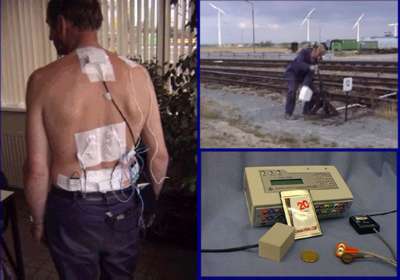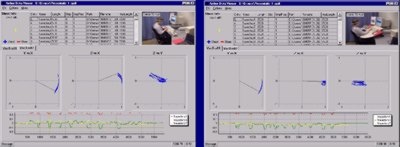
Quantitative assessment of low back load exposure outside the laboratory
C.T.M. Baten
Roessingh Research and Development, Enschede, The Netherlands
In modern western society a high level of job specialization has brought about the still increasing socio-economical problem of work-related disorders, e.g. low back complaints. It has been reported in several studies that in a large number of cases of back complaints the causal mechanisms are directly related to forces occurring in the vertebral colon. This paper introduces an instrument for ambulatory monitoring of the moments and forces occurring in the low back in relation to internal and external conditions, called AMBER. The system monitors posture and movement of the trunk as well as surface EMG signals of some trunk muscles and uses this information to estimate spinal moments, allowing for future estimating of spinal forces. The method links all data to synchronized video images to assist interpretation and to allow for a link to work organization analysis. The spinal extension moment is estimated in two parts. The first part, representing the contribution of trunk and head is estimated using posture and movement of the trunk [1,2]. The second part, representing the contribution of arm movement and load handling, is estimated using the activation level of the erector truncii muscles, assessed with surface EMG, in combination with posture and movement of the trunk. For this a self-learning calibration procedure is developed relating the surface EMG signals to the moment contribution under different conditions of posture, movement and known external loads [3].
Figure 1 shows the physical set-up (a, b) and recording hardware (c). Trunk disk at spinal level L5/S1 are estimated. For situations of symmetrical loading the spinal compression force is also estimated following a single muscle equivalent model. For assisting valid interpretation synchronized video images are displayed with the various data representations (see Figure 2).

Figure 1. Physical setup of an AMBER monitoring session. A. Inertial sensors are placed on the skin of the back above vertebras L3 and T10; surface EMG sensors are placed on the skin above the erector truncii at levels L3 and T10, 3 cm left and right of the middle axis. The data acquisition module is placed at the waist (right side). B. A railway employee with an AMBER system mounted performing his job unhindered. C. The AMBER recording hardware.
For work place analysis the following information is generated by the AMBER method. First trajectories and descriptive statistics are generated for the trunk kinematics. These include absolute 3D trunk orientation, angular acceleration, angular velocity and linear acceleration. Also surface EMG trajectories and descriptive statistics are generated. Then trajectories and descriptives for the spinal extension moments around a rotation point thought in the intervertebral disk at spinal level L5/S1 are estimated. For situations of symmetrical loading the spinal compression force is also estimated following a single muscle equivalent model. For assisting valid interpretation synchronized video images are displayed with the various data representations (see Figure 2)

Figure 2. Visualization of back load exposure data synchronized with video footage. Head movement relative to the trunk at standard computer work place (a) and an adapted computer work place for whiplash patients (b) are shown. In both cases the three upper graphs show the trajectories of 'point of the nose' in a top view, a side view and a frontal view. The lower graph shows the time course of three components of the 3D 'nose' vector in the trunk coordinate system
Paper presented at Measuring Behavior 2000, 3rd International Conference on Methods and Techniques in Behavioral Research, 15-18 August 2000, Nijmegen, The Netherlands